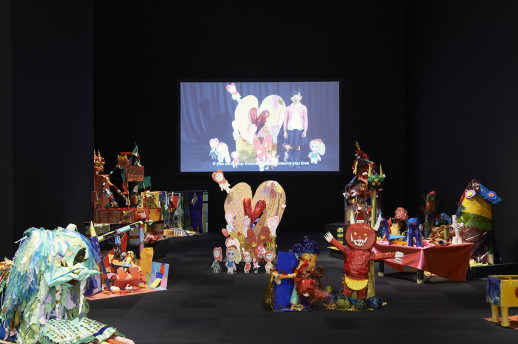New Hell: Interview with Takayuki Yamamoto
The Mori Art Museum has built a reputation for large-scale, single-themed exhibitions; happiness, medicine, laughter and nature have all been past subjects. “Go-Betweens: The World Seen Through Children,” through to August 31, follows in this tradition and has childhood as its focus.
The works on display mostly favour sweetness and innocence, and, with the exception of Tomoko Kikuchi’s heartbreaking video Lost Boundaries (2012), about the painful vulnerability of a young teen in urban China, most are appealing to the wonder-filled gaze of young audiences and adults alike. Zhang O takes photographs of loving fathers with their adopted daughters in the series “Daddy & I”; Won Seoung Won makes everyday spaces into fantasy worlds in the “My Age of Seven” series; Kayo Ume has black-and-white photographs of junior high school girls as they play up and perform juvenile gags for the camera; and Rineke Dijkstra’s I See a Woman Crying (2009) is a film about some northern English classmates talking about Pablo Picasso’s The Weeping Woman (1937). These works, in their own ways, all explore the subjectivity of children, rather than the adult perceptions imposed upon them.

Out of the many interesting works in the exhibition, nobody privileges the subjectivity of children quite like Takayuki Yamamoto and his New Hell: What Kind of Hell Will We Go To?, Tokyo (2014) project. The work, which has been reproduced previously in a handful of locations around the world, was commissioned especially for “Go-Betweens” and involves the contributions of several young Tokyo residents. The objects on display, various dioramas made from papier maché and crayons, and their accompanying video, are the result of a four-day workshop Yamamoto conducted to encourage the young creators to imagine what hell would be like.
Yamamoto sat for a short interview just before the exhibition’s press briefing to talk about his work in more detail. It started with an explanation of where the idea came from. “In a practical sense, I wanted to include my reality in my art practice, and children were my reality,” began the artist. “After college, I traveled around Europe. But then I had to come back to the real world and start my teaching job in Japan. For many years, I was a teacher as well as an artist and I wanted to include that side of my life in my art practice.”
“In the workshops, I behave like a teacher,” Yamamoto continued. “I grab their attention and direct it towards the project. Of course, if you leave kids to make whatever they want, they will probably just want to make Martians. As the artist, I create the situation. I want to encourage them to channel their creativity into thinking about what is possible. They start by following me, but by the end, I’ve stepped back and they are in control. I have become just the cameraman and the director.”

Yamamoto’s method begins by introducing the children to a special part of Japanese art history. Buddhist mandala, or map-like paintings, from the Kamakura period (1185-1333) were particularly graphic in their representations of hell—a stage of existence, known as jigokudo, that all people must pass through in order to get to heaven. “I show the mandala to show that hell is real. Well, at least it seemed real to our ancestors,” explained Yamamoto. “The Buddhists used the mandala to give an idea of what happens to people in the six stages of existence. Hell is but one stage that we must go through, and once you have passed through you get closer to heaven. If you have been good, hell won’t be so bad. Maybe you’ll just have to sit in hot water for five minutes.”
Upon being shown the pictures, “the children are really inspired, even shocked,” he said.
“I hate to sound like a cliché but kids are the same everywhere. I’ve had diverse participants—children from Singapore, San Francisco, Croatia, plus three locations in Japan. But basically they are the same. They all offer something adults could never think of.”
When asked what makes children different to adults, Yamamoto asserts that children are the best way for him to create art from outside his own subjectivity. “Whatever the kids make, it will be something new and seemingly impossible to us adults, but who are we to say what is possible and what is not?”
Emily Wakeling
Emily Wakeling



